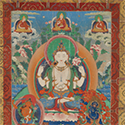|
|
| Show All 56 Results (Text Only) |
|
| Digging Deeper into Buddhism: Mapping the Buddhist Cosmos |
|
|
Students already familiar with Siddhartha Gautama, or Shakyamuni, the Historical Buddha, will deepen their understanding of Buddhist beliefs and artwork. They will analyze and interpret works of art that reveal how people live around the world and what they value. They will identify how works of art reflect times, places, cultures, and beliefs. See also Reading the Cosmic Buddha interactive on Google Arts & Culture.
Go to Museum Resource: https://asia.si.edu/learn/for-educators/teaching-china-with-the-smithsonian/les... | |
|
|
| Diving Deeper into Buddhism – Guanyin |
|
|
Students who are already familiar with Siddhartha Gautama, or Shakyamuni, the Historical Buddha, will deepen their understanding of Buddhist beliefs and artwork. They will analyze and interpret works of art that reveal how people live around the world and what they value. They will identify how works of art reflect times, places, cultures, and beliefs.
Go to Museum Resource: https://asia.si.edu/learn/for-educators/teaching-china-with-the-smithsonian/les... | |
|
|
| Diving Deeper into Buddhism – Western Paradise |
|
|
Students already familiar with Siddhartha Gautama, the Historical Buddha, will deepen their understanding of Buddhist beliefs and artwork. They will analyze and interpret works of art that reveal how people around the world live and what they value. They will identify how works of art reflect times, places, cultures, and beliefs.
Go to Museum Resource: https://asia.si.edu/learn/for-educators/teaching-china-with-the-smithsonian/les... | |
|
|
| Encountering the Buddha: Art and Practice across Asia |
|
|
Buddhism—and the art it inspired—helped shape the cultures of Asia. Today, its extraordinary art is a source of beauty and contemplation for audiences across the world.Encountering the Buddha brings together more than two hundred artworks, spanning two millennia, to explore Asia’s rich Buddhist heritage. They represent diverse schools that arose from the Buddha’s teachings.Throughout the exhibition and the website, we explore how Buddhist artworks are endowed with sacred power. We ask, why were they created? How did Buddhists engage with them? And how do Buddhist understandings of such objects differ from those of art museums?
Go to Museum Resource: https://www.freersackler.si.edu/exhibition/encountering-the-buddha-art-and-prac... | |
|
|
| Exploring Art Made for the Afterlife |
|
|
Students will learn that objects found in tombs provide information about Chinese civilization, including beliefs about the afterlife, aspects of daily life, social hierarchies, and the importance of horses for trade. Students will be able to explain how tombs show how people lived, traveled, and ate, and what they wore in the past. Finally, they will create their own tomb figure inspired by their favorite mode of transportation.
Go to Museum Resource: https://asia.si.edu/learn/for-educators/teaching-china-with-the-smithsonian/les... | |
|
|
|
| Finding Mount Fuji |
|
|
See their Mount Fuji collection, and also their Mount Fuji Pinterest page, compiled by the Education Department at the Freer Sackler. We hope that these works of art inspire study and provoke thought. You can compare and contrast different depictions of Mount Fuji, see how the images changed over time, and analyze works for specific elements. The artworks are a great starting point for visual analysis, historical content, and other research.
Go to Museum Resource: https://asia.si.edu/subject/mount-fuji/ | |
|
|
|
|
| Show All 56 Results (Text Only) |








